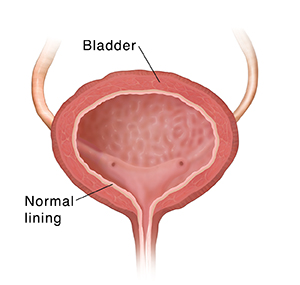What Is Interstitial Cystitis?
Interstitial cystitis is a painful bladder condition. It causes the bladder wall to be sore and easily irritated. This leads to uncomfortable symptoms. Interstitial cystitis is usually chronic (ongoing). There is no known cure. But treatments or a combination of treatments can help manage symptoms to help you feel better.
Your bladder stores urine until it’s passed out of the body. It's not clear what causes interstitial cystitis. But healthcare providers note some changes in the bladder that may be responsible. The protective lining that keeps urine away from your bladder walls seems to thin and stiffen. This makes it hard for the bladder to expand to hold urine. During certain tests, providers may see pinpoints of bleeding (glomerulations) on your bladder wall. In rare cases, they may also find an ulcer (Hunner ulcer).
 |
| Cross section of bladder showing normal lining. |
What are the symptoms of interstitial cystitis?
Symptoms may get worse during the menstrual cycle. Symptoms may go away for a time (remission), but they often come back again. Symptoms include:
-
The frequent and urgent need to pee
-
Pain or pressure in the bladder area, often relieved for a short time after peeing
-
Pain in the genitals, anus, urethra, lower abdomen, or lower back
-
Pain during sex
Some people don't have pain with interstitial cystitis. They have only an intense pressure in the bladder.
What causes interstitial cystitis?
Possible causes include:
-
Damage to the protective bladder lining, allowing urine to irritate your bladder wall
-
Infection or injury of your bladder
-
Allergic reaction in your bladder
-
Nerve problems
-
Substances found in the urine that irritate your bladder
How is interstitial cystitis treated?
Treatment may involve a combination of medicine, lifestyle changes, surgery, and other methods. There is no single known treatment. It may take some time to find the right combination of treatments for you.
Medicine choices include:
-
Pain medicine. These may be used for a short time to help ease discomfort.
-
Antispasmodic medicines. These may help relax the bladder muscles. This may decrease the need to urinate.
-
Nonsteroidal anti-inflammatory drugs (NSAIDs). These may help reduce inflammation and ease pain.
-
Antihistamines. These may help reduce inflammation and ease pain if your provider thinks an allergic reaction is the cause.
-
Antidepressants. In low doses, these may block pain, ease bladder spasms, and help ease symptoms overall.
-
Pentosan polysulfate sodium and similar medicines. These can help ease pain by building and restoring the protective coating of the bladder tissue.
-
Bladder instillation. In some cases, medicine may be flushed directly into the bladder using a catheter.
Other treatments may include:
-
Biofeedback. This treatment uses sensors placed on your belly (abdomen) to let you see signals given off by your bladder muscles. This may help you control your bladder muscles and reduce symptoms.
-
Electrical stimulation. Electrical signals may help block nerve sensations to and from the bladder. This may improve blood flow and strengthen pelvic muscles.
-
Surgery. For severe cases that don't get better with other treatments, surgery may be advised.
-
Botulinum toxin. This can be injected into the bladder lining to relax the muscles of the bladder.
-
Cystoscopy with hydrodistention. This procedure is done in the operating room. It fills the bladder with water to stretch it to full capacity. It often helps with bladder pain and frequency.
Lifestyle changes include:
-
Change in diet. Not eating foods that irritate your bladder and make your symptoms worse. These may include alcohol, citrus fruits, spicy food, chocolate, and caffeine.
-
Bladder retraining. This involves holding urine for longer and longer periods. The goal is to stretch the bladder and increase the amount of urine the bladder can control.
-
Stress management. Stress doesn't cause interstitial cystitis. But any type of chronic pain can be helped by learning ways to help manage stress. Exercise may help, too.
Online Medical Reviewer:
Marianne Fraser MSN RN
Online Medical Reviewer:
Raymond Kent Turley BSN MSN RN
Online Medical Reviewer:
Rita Sather RN
Date Last Reviewed:
8/1/2023
© 2000-2024 The StayWell Company, LLC. All rights reserved. This information is not intended as a substitute for professional medical care. Always follow your healthcare professional's instructions.